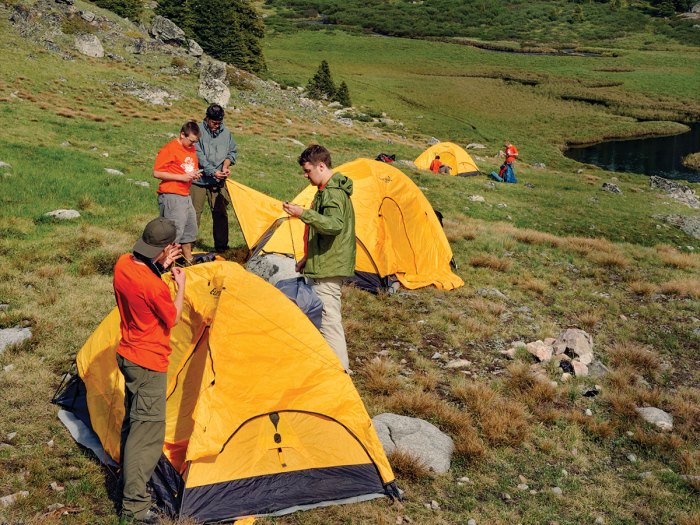How to Choose a Safe and Comfortable Campsite

Picking a place to pitch a tent isn’t always simple. You could find a flat spot, but the site might be in a low-lying area and prone to flooding if it rains a lot.
To find a place you can safely and comfortably sleep and eat outdoors, consider these nine factors:
Environmental Impact
Use established campsites whenever you can, or camp on durable surfaces that won’t be damaged by you and your fellow Scouts when walking around. If you must move objects, like logs or rocks, return everything to its original spot before you leave.
Safety
Pitch your tent away from dead trees or trees with limbs that might fall in a storm. Avoid camping near lone trees, mountaintops, high ridges and other likely lightning targets.
Find a site away from low-lying places that could fill with water during a flash flood, such as valleys, canyons and banks of small, shallow rivers. Some signs of these areas are debris caught in underbrush or grass bent over in the same direction. Higher ground can be dangerous if you see signs of erosion.
Size
Find a place big enough for your patrol to set up its tents, and cook meals in separate areas. Also, make sure there is enough space to move around without tripping over tent stakes and guylines.
Comfort
In the summer, look for a shady site where breezes can help cool your tent and chase away mosquitoes. In the winter, find a site where trees and hillsides provide a natural windbreak. Regardless of the time of year, place your tent on the flattest spot possible.
Water
You’ll need plenty of water for drinking, cooking and cleaning. Public water supplies are the safest and can be found in most frontcountry campsites. Water from streams, rivers or lakes should be properly treated before use. In some dry places, you might need to carry all your water to camp.
Fire
Where fires are not allowed or where wood is scarce, plan on using a camp stove to heat water and cook food. Where fires are permitted, look for a campsite with an existing fire ring. Use firewood that is dead and down; never cut live trees.
Privacy
Respect the privacy of others by selecting campsites away from theirs. Trees, bushes and the shape of the terrain can screen your camp from trails and neighboring campsites. Keep noise down so you won’t disturb nearby campers, and respect quiet hours at public campgrounds and Scout camps.
Terrain
Make sure your site has good drainage, natural ground cover and enough sunlight for visibility.
Permission
Check ahead of time with public parks, forest and reserves. They can issue any permits you will need. Never camp on private property without permission.
Backpacking in the Smokies
Many years ago we were leading a group of scouts on a backpacking hike through the Smokey Mountains. On the first night we were setting up in a sloping campsite. We had food and “smelly stuff” hung on the steel bear cable which was strung between two substantial trees. One of the trees, or possibly a tree uphill from the cable, was not in the best of health. After everyone had setup their tents the adult leaders noticed one tent was positioned slightly downhill from the bear cable. We had them move it uphill away from there.
During the night we heard a bear moving through the campsite. It climbed the “not so healthy” tree. The top half of the tree broke off, scattering our food on the ground. The top half of the tree, about a foot in diameter, landed on the spot the scouts had originally setup their tent.
–Tent Site. Before pitching your tent:
1. Check the prevailing winds to make sure you’re:
a. upwind of a bonfire (sparks burn holes)
b. downwind of a campfire IF mosquitos & no-see-ums are really bad & winds are light.
2. Look for ant nests (esp fire ants) and bee (esp wasp) nests. Ruin your whole weekend!
3. In a wet environment, avoid sites directly under trees, or you’ll never dry out.
4. Dig hip holes for a great night’s sleep, especially important for “stiffer” adults.
–Find a pair of trees to sling food. People and hungry animals are not a good mix!
–Prioritize safety factors over the environmental factors. People first.
I’m not a camper but I have a question you might be able to help with. It’s important to be near a watercourse but often those watercourses are at the bottom of a slope. Is there a way to ensure my site is protected from a rainstorm? I have had unfortunate experiences with this in VT.
Nice
how do you know the rocks are going to fall
Look up to make sure there are no hanging branches or dead trees above the campsite.
Don’t set up your tent near big rocks that could fall.